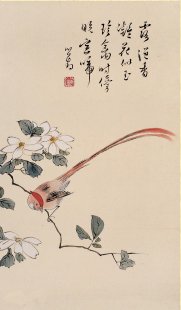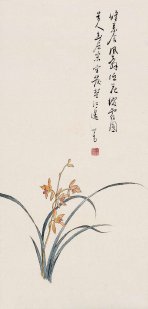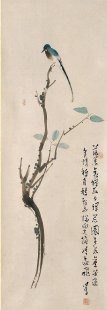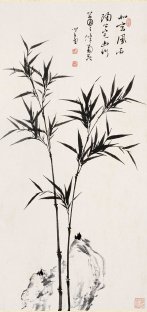



Introduction to Seal Style
Chinese Calligraphy & Seal Carving
for The Association of
Oriental Arts in Irving, Texas
April 8, 2006
(Under construction - please check back for update.)
| About the Association | Seal Basics | Seal Rules | Examples |
| Seal Carving | Books & Videos | Links to Painting & Seals | Referrals |
Many thanks to Ms.
Patterson and Ms. Stuart for their invitation to give
a representation about
Chinese calligraphy in Seal Style and seal carving
related to Chinese brush painting.
We are looking forward to arranging an all-day Chinese calligraphy seminar in the near future.
The Association of Oriental Arts ("Tao Art") was founded by Ms. Iweeta McIntosh in 1979 in Irving, Texas. The Association has periodic exhibitions and seminars to promote the traditional Chinese brush painting and to study the underlying principles of Oriental Brush Painting and the philosophy of TAO.
Every year the Association has exhibitions and seminars at:
Jaycee Park Center for
the Arts
2000 W. Airport Freeway
P.O. Box 153581
Irving, Texas 750015
http://www.irvingart.org/
美國東方藝術協會
在北德州達拉斯大都會區的歐文市
(Irving) 有一個由美籍人士組成的東方藝術協會(THE
ASSOCIATION OF ORIENTAL ARTS),該會成立於一九七九年四月,由
Iweeta McIntosh 女士召集一些中國畫愛好者組成,該會每年有二次向各地邀請國畫名家來舉辦國畫講座及授課,平常也定期有國畫課程,會員們常組團到大陸杭州美院進修中國畫,每位會員都齊全的文房四寶。三十年來,他們對中國畫的熱愛有增無減。每年一月初,他們定期在歐文市的藝術畫廊舉辦年度展,由全體會員提供一年來之精心創作聯合展出,本市中國畫家林伊文、謝鳳蓉、沈鳳等,也是該會之會員,此次有多幅作品參展,被該畫廊選來作為該協會本年度畫展之代表,印刷在歐文畫廊之宣傳單及請柬上,凡前往參觀畫展者,均可在入門處取得此精美之宣傳單,林女士多次應邀擔任該會之國畫課教師。在海外能有如此多美籍人士,醉心於中國繪畫藝術,且學有所成,展示出來,真是直得大家前往欣賞、捧場,給予鼓勵。
(Adapted from http://www.taichie.com/feichang/ziye/8_9_htm/10.htm)
http://www.artzbox.com/articles_chinese/chinesepaintinginfo.htm (painting)
朱文印(陽刻、陽文)
白文印(陰刻、陰文)
The signatures and seal stamps on Chinese painting and calligraphy works follow strict norms and traditions. If they are violated, a work will be mocked or demeaned because it is considered ignorant and impolite. It is sad that the majority of calligraphers and painters in our modern time seem to neglect those norms as established for thousands of years in China.
The following are "selected" translation for basic rules of seals to be stamped on calligraphy and painting works. The main idea is to make the whole work look more "balanced, harmonious, lively, and pleasing to the eyes." Examples of respective applicable rules are explained at the next section "Examples."
|
印章的種類 Kinds of Seals 名章 (Name Seals) 名章泛指作者姓名、字號等代表作者身份的印章,用于作者落款之后。一幅作品有兩方以上名章時要有陰陽變化,且大小最好相近,間隔至少一個章的空位。名章有時也可作手章使用,因其意義比較嚴肅,固以方形為主。 閑章 (Mood Seals, literally Leisure Seals) 閑章是為了豐富畫面、完善構圖而用的章。內容多為與作者的喜好、作品的內容有關的詞句或形象(如座右銘、作畫時間、作畫時的心情、作品的寓意等)。根據用印的位置又可將閑章分為三類: Mood Seals can be further categorized into the following types according to the location where they are stamped on a work: 引首章
(Leading Seals): 壓角章
(Corner Seals): 腰章
(Connecting Seals, literally Waist Seals): 齋館章 (Studio Seals): 以書齋名為主,一般命名皆以堂、齋、居、室、樓等,通常在使用姓名章後,亦可使用書齋名章。主要刻法以朱文為主。 Seals for the artist's studio, study, den, hall, house, living room, or building. Studio Seals are usually stamped after the Name Seals. The artist's studio and name may be combined in one seal. 收藏章
(Collector's Seals):用于書籍等私人收藏。方形、圓形都可,偶爾也有隨形,印面要小,以免造成對藏品的破壞。 手章
(Hand
Seals):指簽署文件、契約等用的私人印信,章面要小,字體要規範。
|
|
一般書畫家,差不多都有一些自用的印章,有姓名印、齋館印、別號印、里氏印、詩詞印、吉語印或啟事印等,這些印如果用的不得當,不但不能為書畫增色,且可招致笑談,所以用印不可不慎。 古人用印都有法度,凡晚輩或屬下致書於尊長的,都用姓名印,平輩相交用字印,尊長與晚輩方可用道號印。用於詩文書畫,如僅用一印,則用姓名印;如用兩印,則姓名印在上、字印在下;用三四印,則姓名印第一、字印第二、道號印第三、齋館印第四。因為先有姓名,再有字、號、齋館,所以不能先後倒置。 用印時,如用兩方印,古法是白文與白文合用、朱文與朱文合用,近世則朱白文合用,普通為白文印在上、朱文印在下,有名有字,即為對章。在畫幅中用印時,尤需注意印之距離與高低,如寫七言的對聯,下聯落款宜在第三字與第四字之間,而用印則應視款字的大小而定,若印為一寸大小,用兩方印時,兩方印相距應一寸左右,過遠過近均不甚雅。如寫一幀單條,則落款必須在主文左下方,但不可太靠下方,不然,與主文平腳,則印無法鈐蓋,即使留有一印之空白,將印鈐蓋其上,亦必不適宜。書畫落款固然重要,而鈐印則視款之高低而定,如落款不小心,過於低落,可以把印鈐在姓名左邊,使豔紅的顏色,襯於黧黑之中,便可反俗為雅。 印之大小,總以較款字稍小為合度,若大於款書,則有喧賓奪主之勢;又有聯珠印,刻二小印,中有距離而印身相連,若倒凹字形,可用於扇箑及小形書畫。此事雖無定法,但多看古人書畫,即可了然於心。 書畫上用的閑章多為詩文印、齋館印,方的、長的、自然形的都有,長方的或橢圓的以及自然形的,可以作為「引首章」用。所謂引首,用於書幅開始或畫幅題字的起首第一字或第一二字之間,視幅度的長短、印章的大小稍有高低,但總在開首部份。詩詞文句印、齋館印、吉語印乃至肖形印,不論方的、圓的、自然形的,如果形狀較大,均可以用於書件的右下角、畫件的左右下角,謂之「押角章」。押角必須書畫件的角落有空白之餘地,襯上一方紅色印章,使之更為生色,但鈐蓋的位置不可太低,低則有侷促之感,應離書畫件之邊角有適當距離,視印之大小與書畫件大小而定。個別欣賞印章是一種藝術品;配合書畫的印章又是另一種深刻的情味。顏色的對比、空間的安排,醞釀著雋永可感的美,「篆刻藝術」就這樣把美感的層次,提昇到更高的境界。 (摘自王北岳先生的篆刻藝術) 用印題款的忌諱 書畫上落款蓋印,印比字大不可以。大幅蓋大印,小幅蓋小印,理所當然。 國畫直幅落款字下蓋印,直下底角,不可再蓋壓角閑章。如右上落款,左下角可蓋閑章,左上落款,右下角可蓋閑章。如上款字印接近下角,閑章就不需蓋了。 國畫棋幅落款,左右兩頭角邊,不可蓋閑章。右上落款,左下角可蓋方形閑章,左下落款,右下角可蓋方形閑章。此處如不需要蓋閑章,而勉強蓋上,反而弄巧成拙。 長方形,圓形,長圓形閑章,爾不可蓋在下角方形壓角閑章處之地位。 方形閑章,不可蓋在書畫上端空白處,就喧賓奪主了。 國畫直幅落款,字行末行末字,與他行字長短,不可整齊,蓋印亦如此。 蓋二印,一方形,一圓形,不可匹配。同形印可匹配。 蓋二印,一大一小,不可匹配。同樣大小可匹配。 蓋二印,一長方形,一橢圓形,不可匹配。同形印可匹配。 蓋二印,上陽文,下陰文,不可匹配,。而上陰下陽可匹配。(examples) 蓋二印,上陽文,下陽文,不可匹配。而上陰下陽可匹配。 蓋二印,上陰文,下陰文,不可匹配。而上陰下陽可匹配。 落款蓋印之下,不可再題字,。印章上下有字掣肘,就失去自然現象。 已經落款蓋印字畫,款後不可再落上款贈人,就失敬了。 花頭,鳥尾,樹枝,山頂上,不可落款蓋印。這是畫家最起碼的常識,不可不懂。 匠刻印章,不可用於書畫上,需用藝術篆刻家,所刻石章最佳。 普通印,不適用於書畫上,要用八寶印泥。 蓋二印,距離不可太遠太近,相隔一個印距離正好。 蓋二印,印文,章法,刀法各異,不可匹配。要用相同刀法所刻印章。 畫上不可題打油詩,一來識者奚,落二來作品就貶為低俗。 上款上端不可蓋閑章,壓在人名頭上,人家很忌諱。一來失禮,二來破壞了畫面。 蓋壓角閑章,不可太小,宣紙四開,用方形石印,大約三公分,比較適合。 蓋壓角閑章,不可蓋二方上,一方正好。印與邊距離約一.五公分為適合。 落款字下不蓋印,而偏要蓋在款字左右,脫離字行,而成畫外物,特殊情形例外。 書畫上,不可蓋上劈頭大印,破壞美麗的畫面。 小畫不可題大字,大畫不可題小字。小空不可題字多,大空不可題字少。 書畫上姓名印,不可連蓋三印以上,應蓋二印,或一印妥當。 書畫上下左右,不可任意蓋印。蓋多不當,不如少蓋,印章印泥不佳,倒不如不蓋好。 蓋二印,不可東倒西歪,如何蓋法,用力輕重,印章印泥保養,一切要潛心研究,不可忽視。 書法四聯首幅,右上可蓋印首小長形章,其餘不可蓋。
|
|
|
|
傳世溥儒款偽作居多,但很好鑒定。 一、印章不對是假的。 二、印色不對是假的,溥心畬用的是家傳皇宮中制作的特殊的印泥。 三、書法不好是假的。 四、繪畫不能筆筆精到是假的,因溥儒會寫“游絲書法”,所以畫中極細的筆劃都非常精到。 五、格調不高是假的,溥儒的生活經歷和修養決定了他繪畫中內涵著高格調 六、顏色不好及匠氣的都是假的,因溥儒用的顏色全是宮中的礦物質顏料,表現在畫上透而高雅,所以顏色不好是假的。 |
|
|
Several kinds of seals on a piece
|
Machine Made Seals vs. Hand Carved Seals |
|
|
Machine Made Seals |
Hand Carved Seals |
|
Machines are operated by those who have not studied Chinese calligraphy, Seal Style scripts, literature, and seal carving. |
Done by seal carving artists who have studied Chinese calligraphy, Seal Style scripts, literature, and seal carving for many years. |
|
Usually stated prices |
Usually commissioned |
|
Look more artificial and vulgar; lack of originality |
More spirit consonance, profoundity, artistry, and elegant design |
|
Use cheap stones and low quality of seal paste |
Use better quality stones and seal paste |
|
If used on Chinese painting or calligraphy works, the person will get demeaned, mocked, and ridiculed. |
Suitable for Chinese painting and calligraphy works |
http://www.asia.si.edu/collections/pinky.cfm?group=Chinese%20Art&start=60 (Samples of Chinese paintings)
Registration and login are REQUIRED to view and save high quality pictures. Please scroll down a little bit to the respective forum. The topics at top are "announcements."
http://www.sf108.com/bbs/forumdisplay.php?fid=56 (Painting)
http://www.sf108.com/bbs/forumdisplay.php?fid=55 (Seals)
http://www.orientgallery.org/photogallery/thumbnails.php?album=11 (Seals)
More links at http://www.art-virtue.com/links/links.htm#3.
If
you are interested in getting a seal carved by professional artists, please
email Joshua at art.virtue@live.com.
If you are looking for seal stones, calligraphy, and painting tools and
supplies, please visit http://www.art-virtue.com/links/links.htm#4.
The "Forbidden City" in Richardson is also listed there. It's the
wholesale store where we may get tools and supplies.